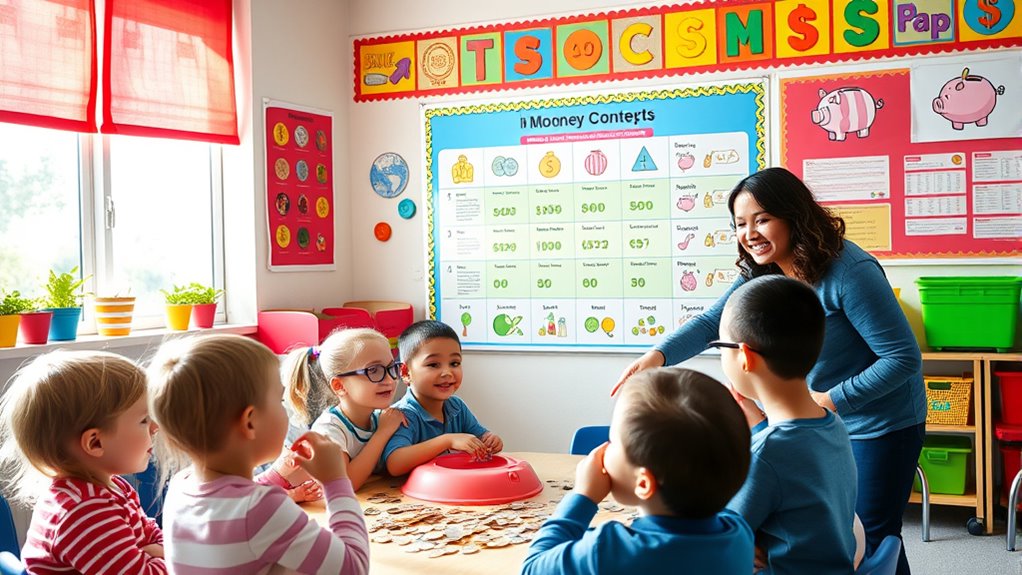To teach your kids practical money skills, start with allowances and assign them clear categories like saving, spending, and giving. Help them set savings goals and use visual jars to track progress. Involve them in shopping to teach decision-making and compare options. Practice patience and celebrate small wins to reinforce good habits. Building these foundational skills now prepares them for smarter financial choices later. Keep exploring strategies to support their financial literacy journey.
Key Takeaways
- Use allowances to teach kids about budgeting, saving, and giving by dividing money into labeled jars or envelopes.
- Involve children in shopping to compare prices, evaluate options, and make informed spending decisions.
- Set savings goals for tangible items or experiences to motivate responsible money management.
- Incorporate real-life financial activities, like paying for small purchases, to teach practical decision-making skills.
- Practice patience and consistency, celebrating small successes to build foundational financial literacy over time.

Have you ever wondered why teaching kids about money matters? Introducing children to financial concepts early on can set the foundation for responsible money management later in life. When you focus on developing their understanding of money, you give them essential skills that influence their ability to make informed decisions, control spending, and build financial security. One of the most effective ways to do this is by teaching them about money management. Kids need to grasp how money flows—how earning, saving, and spending are interconnected. You can start with simple activities, like giving them an allowance and helping them allocate it into different categories, such as saving, spending, and giving. This approach encourages them to think about their money’s purpose and learn to prioritize their needs and wants.
In addition, introducing saving strategies early helps kids understand the importance of setting aside money for future goals. You might encourage them to save a portion of their allowance or earnings from small chores. Make it fun by using clear jars or piggy banks labeled for different purposes, so they can visually see their progress. As they watch their savings grow, they’ll begin to understand the value of patience and discipline. Reinforcing these concepts with specific goals, like saving for a toy or a special outing, makes the process relatable and motivating. Explaining that saving money isn’t just about restricting spending but about planning for what they really want helps them develop a healthy attitude towards money. Additionally, understanding contrast ratio and how it affects the quality of images can be incorporated into teaching them about value and quality in their choices, making the learning process more comprehensive.
You can also involve children in your own financial decisions to boost their understanding of money management. For example, when shopping, let them help compare prices or choose between options, explaining why one might be a better deal. This hands-on experience teaches them to evaluate costs and make smarter choices. Using real-life situations to highlight the importance of saving strategies and prudent spending creates practical learning moments. Remember, the goal isn’t to make them experts overnight but to instill foundational skills that will grow with them. Consistency and patience are key; praise their efforts and celebrate small wins to keep them motivated.
Frequently Asked Questions
When Should I Start Teaching My Child About Money?
You should start teaching your child about money as early as age three, focusing on simple concepts like saving and spending. Early lessons help develop good money habits and set the foundation for financial independence. As they grow, introduce more complex ideas like budgeting and responsible borrowing. By consistently engaging in money conversations, you empower your child to make smart financial choices and build confidence in managing their finances.
How Can I Make Financial Lessons Fun for Kids?
To make financial lessons fun, you can use interactive games that turn learning into a playful experience, like pretend shopping or saving challenges. Incorporate storytelling techniques to create engaging scenarios where your child can learn money concepts through stories and characters. These methods keep your child interested, reinforce lessons naturally, and help them understand money management in a memorable, enjoyable way.
What Are Age-Appropriate Money Skills for Preschoolers?
You’ll want to teach preschoolers basic money skills by introducing toy money to make learning fun and tangible. Show them how saving jars work by labeling jars for spending, saving, and sharing. This helps them understand the concept of managing money and setting goals. Keep it simple and playful, because at this age, money lessons are best learned through stories, games, and lots of encouragement—no financial jargon required!
How Do I Handle Allowances and Chores Effectively?
You handle allowances and chores effectively by establishing clear chore reward systems and allowing allowance negotiation. Set consistent expectations, so your child knows what chores earn what allowance. Encourage open discussions about the allowance amount and chores, making it a negotiation rather than a fixed rule. Reinforce responsibility and independence by rewarding effort and consistency, helping your child understand the value of earning money through their work.
What Are Common Mistakes to Avoid in Teaching Kids About Money?
Don’t fall for money myths that can mislead your kids, like thinking they need a lot of money to be happy. Avoid using confusing financial jargon that leaves them in the dark. Instead, keep it simple and honest, showing them real-world examples. If you’re not careful, you might overwhelm them or give false impressions. Remember, teaching with clarity and patience helps them develop healthy money habits early on.
Conclusion
By teaching kids about money now, you’re giving them a solid foundation for the future. Remember, “A penny saved is a penny earned,” so encourage smart saving and spending habits early on. Your guidance helps them build confidence and responsibility with finances. Keep it simple, stay patient, and watch them grow into financially savvy individuals. Every small step counts—your efforts today will pay off tomorrow.










